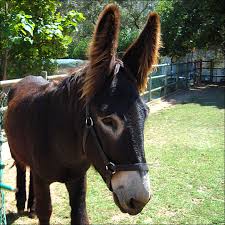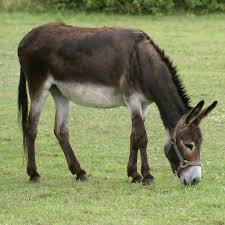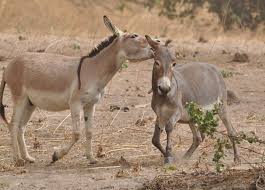The donkey or ass is a domesticated member of the horse family, Equidae. The wild ancestor of the donkey is
the African wild ass, E. africanus. The donkey has been used as a working animal for at least 5000 years.
There are more than 40 million donkeys in the world, mostly in underdeveloped countries, where they are used
principally as draught or pack animals. Working donkeys are often associated with those living at or below
subsistence levels. Small numbers of donkeys are kept for breeding or as pets in developed countries.
A male donkey or ass is called a jack, a female a jenny or jennet; a young donkey is a foal. Jack donkeys
are often used to mate with female horses to produce mules; the biological "reciprocal" of a mule, from a
stallion and jenny as its parents instead, is called a hinny.
Asses were first domesticated around 3000 BC, probably in Egypt or Mesopotamia, and have spread around the
world. They continue to fill important roles in many places today. While domesticated species are increasing in
numbers, the African wild ass is an endangered species. As beasts of burden and companions, asses and donkeys
have worked together with humans for millennia.
Description
Donkeys vary considerably in size, depending on breed and management. The height at the withers ranges from
7.3 to 15.3 hands (31 to 63 inches, 79 to 160 cm), and the weight from 80 to 480 kg (180 to 1,060 lb).
Working donkeys in the poorest countries have a life expectancy of 12 to 15 years; in more prosperous
countries, they may have a lifespan of 30 to 50 years.
ed to marginal desert lands. Unlike wild and feral horses, wild donkeys in dry areas are
solitary and do not form harems. Each adult donkey establishes a home range; breeding over a large area may
be dominated by one jack. The loud call or bray of the donkey, which typically lasts for twenty
seconds and can be heard for over three kilometres, may help keep in contact with other donkeys over the wide
spaces of the desert. Donkeys have large ears, which may pick up more distant sounds, and may help cool the
donkey's blood. Donkeys can defend themselves by biting, striking with the front hooves or kicking with the
hind legs.
History
The ancestors of the modern donkey are the Nubian and Somalian subspecies of African wild ass. Remains of
domestic donkeys dating to the fourth millennium BC have been found in Ma'adi in Lower Egypt, and it is
believed that the domestication of the donkey was accomplished long after the domestication of cattle, sheep
and goats in the seventh and eighth millennia BC. Donkeys were probably first domesticated by pastoral
people in Nubia, and they supplanted the ox as the chief pack animal of that culture. The domestication of
donkeys served to increase the mobility of pastoral cultures, having the advantage over ruminants of not
needing time to chew their cud, and were vital in the development of long-distance trade across Egypt. In
the Dynasty IV era of Egypt, between 2675 and 2565 BC, wealthy members of society were known to own over
1,000 donkeys, employed in agriculture, as dairy and meat animals and as pack animals. In 2003, the tomb of
either King Narmer or King Hor-Aha (two of the first Egyptian pharaohs) was excavated and the skeletons of
ten donkeys were found buried in a manner usually used with high ranking humans. These burials show the
importance of donkeys to the early Egyptian state and its ruler.

By the end of the fourth millennium BC, the donkey had spread to Southwest Asia, and the main breeding center
had shifted to Mesopotamia by 1800 BC. The breeding of large, white riding asses made Damascus famous,
while Syrian breeders developed at least three other breeds, including one preferred by women for its easy
gait. The Muscat or Yemen ass was developed in Arabia. By the second millennium BC, the donkey was brought to
Europe, possibly at the same time as viticulture was introduced, as the donkey is associated with the Syrian
god of wine, Dionysus. Greeks spread both of these to many of their colonies, including those in what are
now Italy, France and Spain; Romans dispersed them throughout their empire.
The first donkeys came to the Americas on ships of the Second Voyage of Christopher Columbus, and were
landed at Hispaniola in 1495. The first to reach North America may have been two animals taken to Mexico by
Juan de Zumárraga, the first bishop of Mexico, who arrived there on 6 December 1528, while the first donkeys
to reach what is now the United States may have crossed the Rio Grande with Juan de Oñate in April 1598.
From that time on they spread northward, finding use in missions and mines. Donkeys were documented as
present in what today is Arizona in 1679. By the Gold Rush years of the 19th century, the burro was the
beast of burden of choice of early prospectors in the western United States. With the end of the placer
mining boom, many of them escaped or were abandoned, and a feral population established itself.
Breeding
A jenny is normally pregnant for about 12 months, though the gestation period varies from 11 to 14
months, and usually gives birth to a single foal. Births of twins are rare, though less so than in horses.
About 1.7 percent of donkey pregnancies result in twins; both foals survive in about 14 percent of those. In
general jennies have a conception rate that is lower than that of horses (i.e. less than the 60-65% rate for
mares).
Although jennies come into heat within 9 or 10 days of giving birth, their fertility remains low, and it is
likely the reproductive tract has not returned to normal. Thus it is usual to wait one or two further
oestrous cycles before rebreeding, unlike the practice with mares. Jennies are usually very protective of
their foals, and some will not come into estrus while they have a foal at side. The time lapse involved in
rebreeding, and the length of a jenny's gestation, means that a jenny will have fewer than one foal per year.
Because of this and the longer gestation period, donkey breeders do not expect to obtain a foal every year,
as horse breeders often do, but may plan for three foals in four years.
Donkeys can interbreed with other members of the family Equidae, and are commonly interbred with horses. The
hybrid between a jack and a mare is a mule, valued as a working and riding animal in many countries. Some
large donkey breeds such as the Asino di Martina Franca, the Baudet de Poitou and the Mammoth Jack are
raised only for mule production. The hybrid between a stallion and a jenny is a hinny, and is less common.
Like other inter-species hybrids, mules and hinnies are usually sterile. Donkeys can also breed with zebras
in which the offspring is called a zonkey (among other names).
Behavior
Donkeys have a notorious reputation for stubbornness, but this has been attributed to a much stronger sense
of self-preservation than exhibited by horses. Likely based on a stronger prey instinct and a weaker
connection with man, it is considerably more difficult to force or frighten a donkey into doing something it
perceives to be dangerous for whatever reason, and donkeys can react violently when they do feel threatened.
Once a person has earned their confidence they can be willing and companionable partners and very dependable
in work.
Although formal studies of their behaviour and cognition are rather limited, donkeys appear to be quite
intelligent, cautious, friendly, playful, and eager to learn.
Due to the donkey's behavior, the name "ass/arse" became synonymous, in the English-language, with persons
who display similar characteristics in a negative connotation.








